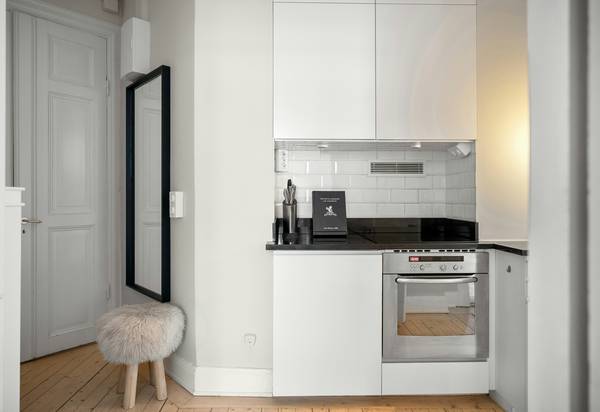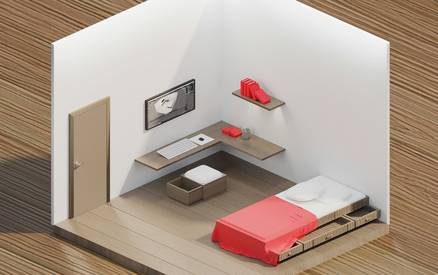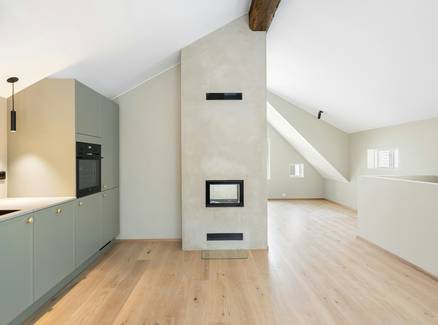
Heating Small Spaces: Challenges & Considerations
Heating small spaces like apartments, studios, and tiny homes comes with unique challenges: limited square footage, strict building codes, and landlord or condo association rules often restrict stove selection and installation methods. Many apartments and rental units prohibit vented stoves or open flames altogether, while tiny homes must comply with RV or tiny house codes requiring specific clearance, venting, and fire safety features. In these environments, choosing the right stove is about more than just size—it's about energy efficiency, safety compliance, and making the most of every square foot. This guide covers the best compact wood, pellet, gas, electric, and multi-fuel stoves tailored for small space living, along with installation tips and legal considerations to help you heat your home safely and stylishly.
How to ChooseChoosing the Right Size Stove for Tiny Spaces
One of the most important factors in small space heating is selecting a stove with the correct BTU (British Thermal Unit) output. An oversized stove can overheat your room, waste fuel, and pose safety risks, while an undersized unit may struggle to keep you comfortable. For apartments, studios, and tiny homes, follow these steps:
- Measure your space (length × width × ceiling height) to determine the cubic footage.
- Use a BTU calculator — a general rule is 20–25 BTUs per square foot for insulated spaces. For example, a 300 sq. ft. studio needs around 6,000–7,500 BTUs. Use our Heating Stove BTU Calculator for precise sizing.
- Apply a safety margin: Don’t oversize. Select a stove whose lowest setting is comfortable in mild weather, not just cold snaps.
- Factor in insulation, ceiling height, and climate: Poorly insulated or high-ceiling rooms may require more BTUs. Use our heating stove sizing guide for details.
- Check code requirements: Many local codes restrict stove output or require additional safety features in small dwellings. Always verify before purchasing.

Best Heating Stove Types for Small Spaces
1. Electric Stoves
- Plug-and-play simplicity—no venting required
- Ideal for apartments, rentals, and tiny homes
- Safe, cool exteriors (in most models) and tip-over protection
- Available in tabletop, wall-mounted, and freestanding styles
2. Compact Wood Stoves
- Small fireboxes (0.5–1.5 cubic feet) designed for tiny homes and cabins
- Off-grid capable—no electricity required
- Requires proper venting and clearances
- Choose EPA-certified models for safety and clean burning
3. Small Pellet Stoves
- Automated fuel feeding and efficient heating in a compact footprint
- Direct vent options for installation flexibility
- Hopper capacities as small as 20 lbs for apartments or studios
4. Gas Stoves & Wall Heaters
- Direct vent and vent-free options for urban or rural settings
- Instant heat, low maintenance, thermostat or remote control
- Wall-mounted models save floor space and provide zone heating
5. Multi-Fuel Stoves
- Burns wood, pellets, or other approved fuels
- Versatile for off-grid or emergency use
- Requires careful sizing and setup for small spaces
Comparison Table: Pros & Cons of Small Space Stove Types
| Stove Type | Best For | Pros | Cons | Long-Tail Keyword Example |
|---|---|---|---|---|
| Electric | Apartments, rentals, bedrooms |
|
|
best electric stove for apartments |
| Wood | Tiny homes, cabins, off-grid |
|
|
best small wood stove for cabins |
| Pellet | Studios, small homes, energy conscious |
|
|
top compact pellet stove for apartments |
| Gas | Urban homes, condos, quick heat |
|
|
wall-mounted gas heater for tiny homes |
| Multi-Fuel | Flexible/backup heat |
|
|
small space multi-fuel stove |
Installation & Venting Tips for Small Spaces
Step-by-Step Installation for Small Space Stoves
- Check local codes & building rules: Confirm what's permitted for your dwelling (apartment, condo, tiny home).
- Choose a code-compliant location: Place stoves away from windows, doors, combustibles, and traffic paths. Use manufacturer and NFPA 211 clearances.
- Prepare the hearth or floor: Install a non-combustible hearth pad or wall shields as required. For wall-mounted gas heaters, use included brackets and check wall type.
- Install venting:
- For wood/pellet: Use insulated stovepipe or direct vent kit, exiting vertically through the roof or horizontally per code. Seal all joints, use firestops, and maintain minimum clearances. Learn more about venting.
- For gas: Direct vent models have concentric pipe; vent-free require no exterior vent but must meet room size requirements.
- For electric: No venting required. Place on a stable, flat surface, away from fabrics or water sources.
- Install smoke & CO detectors nearby, per code.
- Final inspection: Have a certified professional or building inspector review your setup if required.
For visual learners, consider these diagrams for your installation:
- Vertical venting in a tiny house: Show stove, double-wall pipe, roof exit, and minimum clearances to walls and ceiling.
- Horizontal direct vent in apartment: Show wall penetration, firestop, outside vent cap, and room side heater.
- Wall-mount gas heater installation: Show mounting brackets, gas line, safety shutoff, and wall spacers.

Legal and Insurance Considerations for Stoves in Rental Properties and Condos
- Can I install a wood stove in my apartment? Usually not—most apartments and condos prohibit wood or pellet stoves due to fire and insurance risks. Always check your lease, HOA, or condo association rules. Consider electric or vent-free gas stoves, which are more commonly allowed. See our stove regulations guide.
- Insurance for small space stoves: Adding any type of stove can affect your renter’s or homeowner’s insurance. Notify your insurer before installation, provide proof of professional installation, and keep documents for code compliance. Non-compliant installations may void your coverage.
- Code requirements for tiny house heating: Many areas require UL/EPA certification, specific venting, hearth protection, and clearance distances. Tiny houses on wheels may be inspected as RVs and follow NFPA 1192 or ANSI A119.5 standards. Check local zoning and building codes before purchase.
- Landlord/tenant permissions: Written permission is required for permanent stove installations in rentals. Portable electric stoves are typically allowed but must still follow fire safety codes.
Before buying or installing any stove:
- Get written approval from your landlord, HOA, or local code official.
- Save all manuals, certifications, and receipts.
- Schedule professional installation (when required) and keep inspection reports.

Key Features to Look for in Small Space Stoves
- Compact Dimensions: Prioritize stoves with a small footprint—many models are under 18" wide or deep.
- Low BTU Output: Target 3,000–20,000 BTUs for rooms up to 500 sq. ft.—oversized stoves can overheat or waste energy.
- Safety Features: Look for tip-over protection, cool-touch surfaces, and automatic shutoff (especially for electric and gas stoves).
- Clearance Requirements: Choose models with reduced wall and floor clearance—some electric and gas stoves can be installed as close as 2–6".
- Style: Modern, classic, or rustic designs are available—even for the tiniest spaces.
Safety & Maintenance for Small Space Stoves
- Install smoke and carbon monoxide alarms—especially in single-room or sleeping areas.
- Maintain clearances—never block vents or place stoves too close to furniture or bedding.
- Schedule regular cleaning of vents, chimneys, and air inlets—even compact stoves need routine maintenance.
- Empty ash pans or trays frequently for wood/pellet stoves.
- Unplug electric stoves before cleaning or moving.
- Review our maintenance guide and cleaning tips for stoves.
Top Picks: Recommended Stoves for Small Spaces
Freestanding Electric Stove
Modern, portable, and safe for apartments—just plug in for instant warmth and ambiance. Look for models with adjustable thermostats and flame-only mode.
Learn MoreTiny Wood Stove
EPA-certified mini wood stoves for cabins, tiny houses, or off-grid studios. Models as small as 12" wide are available.
Learn MoreWall-Mounted Gas Heater
Direct vent or vent-free gas heaters for apartments or studios. Save floor space and enjoy reliable, on-demand heat.
Learn MoreStoves for Small Spaces: Frequently Asked Questions
- Can I install a wood or pellet stove in an apartment? Usually only with landlord and code approval—many apartments restrict vented stoves. Electric or vent-free gas stoves are often better options for rentals. See our certifications and code guide.
- What’s the safest stove for a small room? Electric stoves are typically safest—no combustion, tip-over shutoff, and cool surfaces. Always keep combustibles away from any heat source. Learn more on small space stove safety.
- How do I size a stove for my small space? Use manufacturer BTU charts, aiming for 20–25 BTUs per square foot. Never oversize—too much heat can be uncomfortable or even dangerous. Try our BTU Calculator.
- What’s the most efficient stove for a tiny house? Pellet and modern wood stoves offer great efficiency, but electric and gas are simplest for occasional use or rentals. See our energy efficiency guide.
- Are vent-free stoves safe? When installed and used according to code, vent-free gas stoves can be safe, but always install CO detectors and never use in sleeping areas unless specifically approved.
- How can I improve energy savings in a small space? Seal windows and doors, use programmable thermostats, and insulate. See budget heating tips.
- What insurance issues do I face with adding a stove? Many insurers require professional installation, code compliance, and notification. Non-compliant stoves may void coverage. Review our insurance and legal guide.
- What if my landlord says no to a stove? Explore plug-in portable options (like electric stoves) or ask about vent-free gas heaters with safety features. Always get written permission and review our choosing guide for alternatives.
- Common troubleshooting for small stoves? If your stove smells smoky, check venting for blockages, ensure clearances, and use dry fuel. If it won't start (electric/pellet), check power, hopper, or thermostat. See common issues and troubleshooting guide.
Related Guides
Electric Stoves
Explore the best electric stoves for apartments, studios, and tiny homes—safe, easy, and stylish.
Electric Stove GuideWood Stoves
Compare compact wood stoves and learn how to install one safely in a small space.
Wood Stove GuideChoosing a Heating Stove
Step-by-step advice for picking the perfect stove for your unique space, needs, and budget.
Guide to Choosing